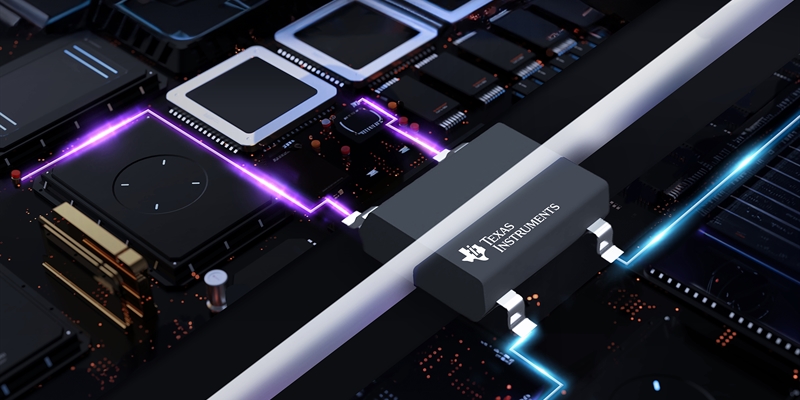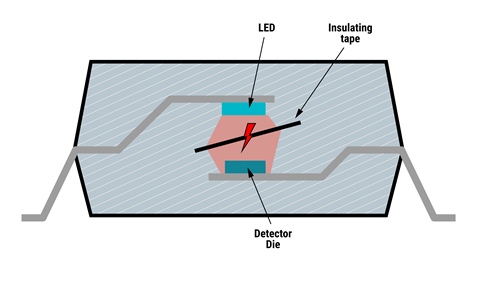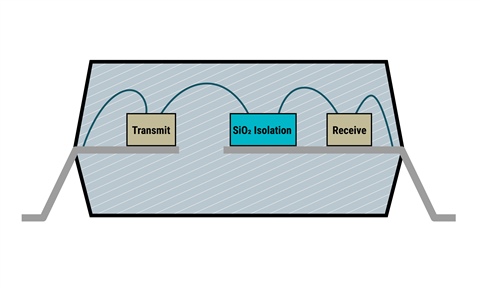SSZTCZ6 September 2023 ISOM8110 , ISOM8610 , ISOM8710 , ISOM8711

Optocouplers, also known as photocouplers, opto-isolators and optical isolators, have long been an option for designers seeking galvanic isolation for their system signals. Around since the 1970s, these semiconductor devices have played an important role in providing safety isolation for industrial and automotive end equipment. However, despite significant advancements, there appears to be a limitation to their progress in electrical characteristics, high-voltage reliability and integration capabilities, prompting designers to explore alternatives.
Technologies such as capacitive and magnetic isolation have emerged as alternatives, offering better overall performance compared to optocouplers. Texas Instruments (TI) has invested in silicon dioxide (SiO2)-based digital isolation technology since the early 2000s, providing digital isolator products that offer the same functionality as optocouplers with some distinct advantages.
Bridging the gap: Introducing opto-emulators
Texas Instruments opto-emulators combine the benefits of traditional optocouplers and TI’s SiO2-based isolation technology. Opto-emulators are pin-to-pin compatible with the industry’s most popular optocouplers, facilitating seamless integration into existing designs while providing equivalent signal behavior. These products appear and behave just like optocouplers from a design engineer’s perspective but leverage TI’s SiO2 technology for the isolation barrier. With the barrier effectively blocking high-voltage signals and preventing ground loops – ensuring system safety and stability – you can harness the advantages of SiO2 isolation, which include enhanced electrical characteristics, improved high-voltage reliability, and the potential to integrate additional system functionality. By creating this type of semiconductor product, our goal is to give you the best of both worlds.
Traditional optocouplers use an LED to transmit digital or analog information across an isolation barrier where a phototransistor detects the signal on the other side; see Figure 1. It is a well-known fact that the LEDs used in optocouplers have an aging or degradation effect over their lifetime. This property of LEDs is a significant headache to system designers and the No. 1 complaint we hear at TI. Additionally, the insulating material used in an optocoupler ranges from just air to epoxies or mold compounds. Table 1 clearly shows the difference in the isolation strength of an optocoupler vs. an opto-emulator using a an SiO2 dielectric.
 Figure 1 Typical optocoupler
construction
Figure 1 Typical optocoupler
construction| Insulator Materials | Technology | Dielectric Strength |
| Air | Optocouplers | ~1 VRMS/µm |
| Epoxies | Optocouplers | ~20 VRMS/µm |
| Silica Filled Mold Compounds | Optocouplers | ~100 VRMS/µm |
| SiO2 | Opto-emulators | ~500 VRMS/µm |
With opto-emulators using TI’s SiO2-based isolation barrier to achieve signal isolation, it’s possible to avoid both of these common optocoupler pitfalls. Figure 2 shows the internal construction of a TI opto-emulator, where the functional behavior of a traditional optocoupler is emulated on the transmit and receive circuits and SiO2 provides the high-voltage isolation.
 Figure 2 Construction of a TI digital
isolator
Figure 2 Construction of a TI digital
isolatorThe advantages of opto-emulators
By integrating advanced isolation technology, opto-emulators can overcome the limitations associated with traditional optocouplers, enabling superior performance and reliability. Let’s discuss a few of the advantages of opto-emulators:
Lower power consumption
Traditional optocouplers require upfront overdesigning to help compensate for the inevitable aging effects of the LED, requiring additional forward current (IF) throughout the design’s lifetime. TI opto-emulators can save you as much as 80% on your power budget by offering a much lower IF and supply current.
Improved common-mode transient immunity (CMTI)
While a common digital optocoupler specifies a CMTI of approximately 15 kV/µs, the ISOM8710 has a minimum CMTI of 125 kV/µs, enabling its use in applications with very high common-mode switching noise or high ringing noise.
A stable and tight current transfer ratio (CTR)
Forget the days of paying extra for a tighter CTR range. TI opto-emulators such as the ISOM8110 come standard with a variety of tight CTR ranges that are stable over temperature.
Fast data rates
Typical high-speed optocouplers support data rates from 1 Mbps up to 10 Mbps, while the ISOM8710 supports 25 Mbps. This support allows for higher throughput and enables the use of opto-emulators in a variety of high-speed applications.
Bandwidth
The ISOM8110 supports a high bandwidth of 680 kHz, enabling a reduction in the size of mandatory magnetics (inductor and transformer). The wide bandwidth enables improved transient responses for secondary-side regulated flyback converters. The improved transient response allows for a reduction in size of output capacitors, freeing up board space and reducing overall system cost, especially in high-switching-frequency gallium nitride designs.
Wide temperature range
The average optocoupler supports a temperature range from 0°C to +85°C. While some optocouplers support a wider temperature range, that feature comes at an additional cost. TI opto-emulators support a temperature range as wide as –55°C to +125°C as the standard offering, and more automotive-qualified devices will be available in 2024.
Reliable isolation
Opto-emulators have improved high-voltage capabilities, making them suitable for applications demanding reliable isolation. TI opto-emulators leverage SiO2 for the insulating barrier, providing 500 V/µm of isolation. This is significantly stronger than the air (1 V/µm) used in many optocouplers on the market.
Conclusion
Opto-emulators represent a significant advancement in signal isolation technology, combining the familiarity of optocouplers with the advantages of SiO2-based isolation. These devices empower you to meet the demands of modern systems, ensuring enhanced performance, reliability and safety. By leveraging opto-emulators, you can optimize your designs and embrace the new era of isolation technology.
Additional resources
If you’re ready to upgrade your designs to opto-emulators, try TI’s cross-reference search, where you can upload the optocouplers you use in your designs today and find the right opto-emulator to match.
Read the white paper, “Addressing High-Voltage Design Challenges with Reliable and Affordable Isolation Technologies,” the application note, "Introduction to Opto-Emulators," and Opto-emulators product portfolio page.